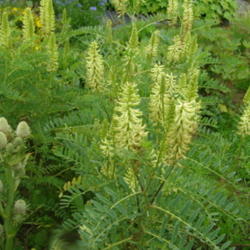General Plant Information (Edit)
| Plant Habit: |
Herb/Forb
|
| Life cycle: |
Perennial
|
| Sun Requirements: |
Full Sun
Full Sun to Partial Shade
|
| Water Preferences: |
Dry
|
| Minimum cold hardiness: |
Zone 2 -45.6 °C (-50 °F) to -42.8 °C (-45°F)
|
| Maximum recommended zone: |
Zone 8a
|
| Plant Height: |
24 - 48 inches |
| Plant Spread: |
24 - 36 inches |
| Fruit: |
Showy
|
| Flowers: |
Showy
|
| Flower Color: |
White
|
| Flower Time: |
Late spring or early summer
Summer
Late summer or early fall
|
| Uses: |
Medicinal Herb
Will Naturalize
|
| Dynamic Accumulator: |
Nitrogen fixer
|
| Wildlife Attractant: |
Bees
Butterflies
|
| Propagation: Seeds: |
Stratify seeds: 8 weeks if you sow indoors
Scarify seeds: seeds germinate rapidly after scarification; no other pretreatment required.
Depth to plant seed: cover the seeds thin
Suitable for wintersowing
Sow in situ
Start indoors
Can handle transplanting
|
| Pollinators: |
Moths and Butterflies
Bees
|
- Canada Milkvetch
- Milk vetch
- Canadian Milk Vetch
- Rattle Vetch
Posted by
ILPARW (southeast Pennsylvania - Zone 6b) on Dec 1, 2021 8:56 AM concerning plant:
This member of the Legume Family has a large range over most of Canada and the US. Unlike a big number of vetches, it is semi-erect, though it sprawls some, and it does not have tendrils. It grows about 1.5 to 3.5 feet high. Its foliage is of alternate compound leaves with 21 to 31 leaflets and is not toxic to foraging mammals like the many species of western North America. The flower clusters (racemes) are whorled with about 75 light yellow to cream flowers that bloom in summer for a long time, even to 2 or 3 months. The dry fruit is a stout oval pod with long pointed tips. The root system develops a taproot. It is pollinated by bumblebees and long-tongued bee species.
Posted by
SongofJoy (Clarksville, TN - Zone 6b) on Jan 22, 2014 10:21 AM concerning plant:
An important food source for birds. Holds its seed into late fall and early winter.
Posted by
SongofJoy (Clarksville, TN - Zone 6b) on Jan 22, 2014 10:22 AM concerning plant:
Host plant for the Western Tailed Blue Butterfly larvae.
Posted by
Johannian (The Black Hills, SD - Zone 4b) on Feb 8, 2022 9:45 PM concerning plant:
Range: western Canada south to the central Sierra Nevada of California, central Nevada, southern Utah, and central New Mexico. Habitat: open meadows and clearings in coniferous forests, along roadside ditches, and near creeks and lakeshores.
Plant Events from our members
| MrsBinWY |
On April 15, 2017 |
Potted up
12 |
| MrsBinWY |
On February 21, 2017 |
Seeds germinated
I let them sit on the counter a few days imbibe. Thought to put them in the fridge this morning, but 17 of the 20 seeds were already up! |
| MrsBinWY |
On February 18, 2017 |
Seeds sown
Initially poured boiling water over the seeds as an attempt to scarify. They didn't appear to swell, so filed; milk jug; fridge for 10 days, then room temp; 20 seeds from molanic |
» Post your own event for this plant
« Add a new plant to the database
» Search the Astragaluses Database: by characteristics or by cultivar name
« See the general plant entry for Astragaluses (Astragalus)
« The Astragaluses Database Front Page
« The Plants Database Front Page







